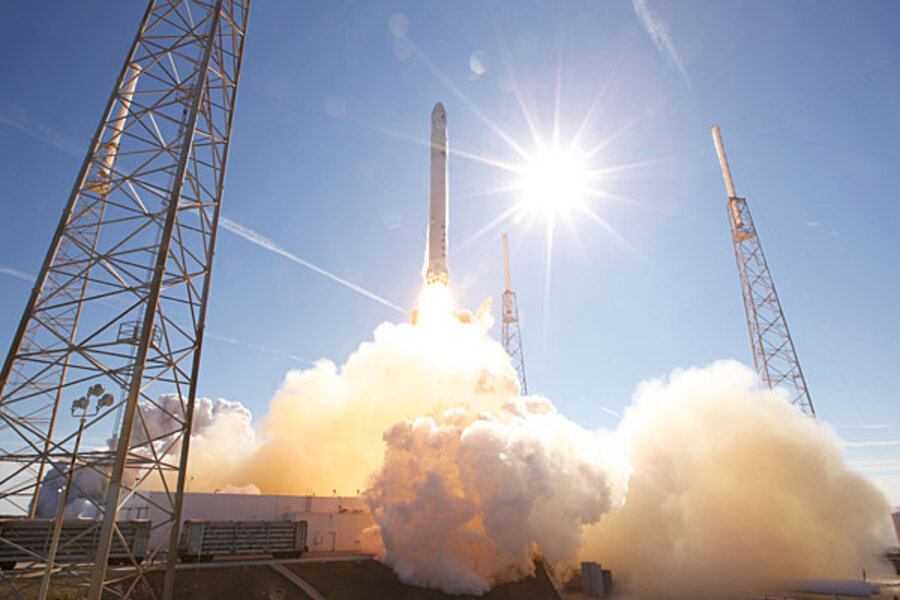All systems go for 'historic' SpaceX launch this month
As a NASA 747 carried the venerable space shuttle Discovery to its retirement home at the Smithsonian Institution's Air and Space Museum annex at Dulles Airport in Virginia on Tuesday, the space agency and its private-industry partner SpaceX were gearing up for a different milestone.
On April 30, SpaceX will launch its Falcon 9 rocket on a demonstration mission to the International Space Station.
The Falcon 9 and its Dragon cargo capsule represent one of two offerings from commercial rocketmakers aimed at replacing the shuttles as space freighters. A second company, Orbital Sciences, is anticipating the maiden test flight of its Antares rocket from Wallops Island, Va., later this year.
The upcoming SpaceX mission represents a “historic launch,” notes Michael Suffredini, NASA's space station program manager.
The event is billed as a demonstration mission. Still, for the space-station program, a successful conclusion would mark the first time a commercial rocket company has delivered supplies to the station and the first time an unmanned vehicle returned cargo to Earth as well.
Three other unmanned resupply vehicles – Russia's Progress vehicles, Europe's Automated Transfer Vehicle, and Japan's H-II Transfer Vehicle – already have made resupply runs to the orbiting outpost. But unlike the Dragon craft, the other carriers also serve as space-station trash incinerators, carrying refuse to burn up on reentry into Earth's atmosphere.
“We've got a pretty good shot” at a successful mission, said SpaceX founder and chief designer Elon Musk, during a briefing on Monday following a design-review meeting NASA held with company representatives.
Reliable commercial carriers serving low-Earth orbit, where the space station swings around the planet once every 90 minutes, are key to NASA's plans for human space exploration.
Within the next five years, NASA aims to send humans to the space station on commercial carriers. With the end of the space-shuttle program, NASA has bought seats on Russian Soyuz capsules for US astronauts serving on space-station crews. Yet the US is slated to continue its participation in the space-station program through 2020, with studies suggesting the outpost could run far longer. The goal is to turn ferry service to and from the station to commercial companies so NASA can focus its human-exploration efforts on moving astronauts beyond low-Earth orbit.
The ability to safely land and retrieve a loaded Dragon cargo carrier is crucial to SpaceX's long-term goal of qualifying its capsule to carry astronauts, as well as hardware, to the orbiting outpost.
In December 2010, the company lofted the Falcon 9-Dragon combination in a spectacularly successful maiden flight from a launch pad at the Kennedy Space Center in Florida. SpaceX became the first commercial company to launch, orbit, and recover a capsule.
While this mission draws on that success with the same rocket and capsule combination, the company is pushing the envelope in other critical areas. The mission is designed to put the capsule's docking hardware and control software through their paces in ways that engineers can't simulate on the ground. The company must demonstrate that it can safely maneuver the craft when it's close to the station.
Test flight or not, NASA isn't letting an opportunity slip to send supplies to the station. Dragon will carry about nearly 1,150 pounds of cargo up, mainly food and some spare parts for the station. The station crew will load nearly 1,500 pounds of cargo, including station components NASA can refurbish and return on a future supply run.
Still, with the uncertainties of a demonstration flight in mind, “each piece of hardware that's going up and each piece we've put on there to come home” has been picked with the notion that it might not survive the trip, Mr. Suffredini said during the briefing.
If the April 30 mission is successful, SpaceX could begin cargo flights early next year under a 12-mission, $1.6 billion deal with NASA. If the coming mission isn't successful, the company still has other launch opportunities this year to try to achieve the goals set for this mission.





